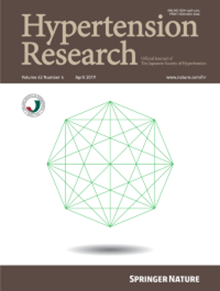低强度等距手握训练对高血压患者家庭血压的影响:随机对照试验。
IF 4.3
2区 医学
Q1 PERIPHERAL VASCULAR DISEASE
引用次数: 0
摘要
我们研究了强度低于通常负荷的等长手握(IHG)训练是否能显著降低接受治疗的日本高血压患者的家庭血压(HBP)。我们将 60 名血压达到 1 级高血压水平的患者(平均年龄 66.9 岁,男性占 44.6%)随机分配到 IHG 组和对照组。IHG组进行为期12周的IHG训练,然后进行为期12周的非训练。对照组不进行任何 IHG 训练。IHG训练包括四组2分钟的等长收缩,收缩量为最大自主收缩(MVC)的15%或平时的一半,包括每组之间休息1分钟,每周≥3天。在前一阶段结束时,对照组的早晚收缩压(HSBP)和晚间舒张压(HDBP)均显著高于基线值,而 IHG 组的早晚收缩压均无变化。在后一阶段结束时,IHG 组的晨间 HBP 比前一阶段结束时有所增加,而对照组则保持不变。IHG 组清晨 HSBP 从基线到前一阶段末的变化(Δ)小于对照组(Δ4.1 mmHg 对 Δ0.0 mmHg,p = 0.05)。在调整基线 HSBP 和季节变化后,也观察到类似的趋势(p = 0.06)。总之,对接受治疗的日本高血压患者进行为期 12 周的 IHG 训练,训练量为 MVC 的 15%,可显著降低清晨 HSBP 约 4.0 mmHg。这项研究表明,对日本高血压患者进行为期 12 周的 IHG 训练,训练强度为运动负荷量的 15%,可将清晨 HSBP 降低约 4.0 mmHg。持续的低强度 IHG 训练可为 1 级高血压人群提供稳定的降压效果。本文章由计算机程序翻译,如有差异,请以英文原文为准。

Effects of low-intensity isometric handgrip training on home blood pressure in hypertensive patients: a randomized controlled trial
We examined if lower intensity isometric handgrip (IHG) training than usual load could significantly reduce home blood pressure (HBP) in treated Japanese hypertensive patients. Sixty patients (mean age, 66.9 years; 44.6% men) with high blood pressure to grade 1 hypertension level were randomly assigned to an IHG or control group. The IHG group performed IHG training for 12 weeks, followed by a 12 weeks of detraining. The control group did not any IHG training. The IHG training comprised four sets of 2-min isometric contractions at 15% of maximum voluntary contraction (MVC) or half than usual, including 1 min of rest between sets, for ≥3 days a week. At the end of the former phase, both morning and evening systolic HBP (HSBP) and evening diastolic HBP (HDBP) were significantly higher than those at baseline in the control group while neither morning nor evening HSBP remained unchanged in the IHG group. Morning HBPs increased at the end of the latter phase than those at the end of the former phase in the IHG group and remained unchanged in the control group. The change (Δ) in morning HSBP from baseline to the end of the former phase was smaller in the IHG group than that in the control group (Δ4.1 mmHg vs. Δ0.0 mmHg, p = 0.05). A similar tendency was observed after adjusting baseline HSBP and seasonal variation (p = 0.06). In conclusion, a 12-week IHG training at 15% of MVC significantly lowered morning HSBP by approximately 4.0 mmHg in treated Japanese hypertensive patients. This study showed that a 12-week IHG training at 15% of MVC significantly lowered morning HSBP by about 4.0 mmHg in treated Japanese hypertensive patients. Continuous low-intensity IHG training may provide a stable hypotensive effect in high blood pressure to grade 1 hypertensive population.
求助全文
通过发布文献求助,成功后即可免费获取论文全文。
去求助
来源期刊

Hypertension Research
医学-外周血管病
CiteScore
7.40
自引率
16.70%
发文量
249
审稿时长
3-8 weeks
期刊介绍:
Hypertension Research is the official publication of the Japanese Society of Hypertension. The journal publishes papers reporting original clinical and experimental research that contribute to the advancement of knowledge in the field of hypertension and related cardiovascular diseases. The journal publishes Review Articles, Articles, Correspondence and Comments.
 求助内容:
求助内容: 应助结果提醒方式:
应助结果提醒方式:


